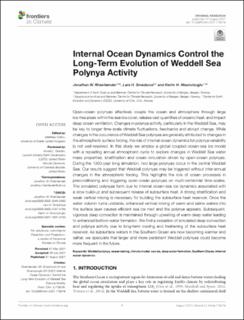| dc.contributor.author | Rheinlænder, Jonathan Winfield | |
| dc.contributor.author | Smedsrud, Lars Henrik | |
| dc.contributor.author | Nisancioglu, Kerim Hestnes | |
| dc.date.accessioned | 2022-02-21T14:27:16Z | |
| dc.date.available | 2022-02-21T14:27:16Z | |
| dc.date.created | 2022-01-28T09:54:22Z | |
| dc.date.issued | 2021 | |
| dc.identifier.issn | 2624-9553 | |
| dc.identifier.uri | https://hdl.handle.net/11250/2980596 | |
| dc.description.abstract | Open-ocean polynyas effectively couple the ocean and atmosphere through large ice-free areas within the sea-ice cover, release vast quantities of oceanic heat, and impact deep ocean ventilation. Changes in polynya activity, particularly in the Weddell Sea, may be key to longer time-scale climate fluctuations, feedbacks and abrupt change. While changes in the occurrence of Weddell Sea polynyas are generally attributed to changes in the atmospheric surface forcing, the role of internal ocean dynamics for polynya variability is not well-resolved. In this study we employ a global coupled ocean-sea ice model with a repeating annual atmospheric cycle to explore changes in Weddell Sea water mass properties, stratification and ocean circulation driven by open-ocean polynyas. During the 1300-year long simulation, two large polynyas occur in the central Weddell Sea. Our results suggest that Weddell polynyas may be triggered without inter-annual changes in the atmospheric forcing. This highlights the role of ocean processes in preconditioning and triggering open-ocean polynyas on multi-centennial time-scales. The simulated polynyas form due to internal ocean-sea ice dynamics associated with a slow build-up and subsequent release of subsurface heat. A strong stratification and weak vertical mixing is necessary for building the subsurface heat reservoir. Once the water column turns unstable, enhanced vertical mixing of warm and saline waters into the surface layer causes efficient sea ice melt and the polynya appears. Subsequent, vigorous deep convection is maintained through upwelling of warm deep water leading to enhanced bottom water formation. We find a cessation of simulated deep convection and polynya activity due to long-term cooling and freshening of the subsurface heat reservoir. As subsurface waters in the Southern Ocean are now becoming warmer and saltier, we speculate that larger and more persistent Weddell polynyas could become more frequent in the future. | en_US |
| dc.language.iso | eng | en_US |
| dc.publisher | Frontiers Media | en_US |
| dc.rights | Navngivelse 4.0 Internasjonal | * |
| dc.rights.uri | http://creativecommons.org/licenses/by/4.0/deed.no | * |
| dc.title | Internal Ocean Dynamics Control the Long-Term Evolution of Weddell Sea Polynya Activity | en_US |
| dc.type | Journal article | en_US |
| dc.type | Peer reviewed | en_US |
| dc.description.version | publishedVersion | en_US |
| dc.rights.holder | Copyright 2021 Rheinlænder, Smedsrud and Nisanciouglu | en_US |
| dc.source.articlenumber | 718016 | en_US |
| cristin.ispublished | true | |
| cristin.fulltext | original | |
| cristin.qualitycode | 1 | |
| dc.identifier.doi | 10.3389/fclim.2021.718016 | |
| dc.identifier.cristin | 1992046 | |
| dc.source.journal | Frontiers in Climate | en_US |
| dc.identifier.citation | Frontiers in Climate. 2021, 3, 718016. | en_US |
| dc.source.volume | 3 | en_US |

